Thick leather offers a greater degree of protection and is generally more hardwearing than thinner leather. Veg-tanned cowhide is by far the most commonly used thick leather. Although bull hide tends to be firmer, thicker and stiffer. That’s not to say that you don’t get other thick leather. Buffalo can be 2-3 times thicker than cowhide. Its thickness ranges from 6-9oz (2.4 – 3.6mm) Ostrich leg leather can be as much as 1.5mm thick.
Thick leather is classified as leather thicker than 1.4mm or 3-4oz (ounces). Leather can be as thick as 6mm or 15 ounces. Leather thickness is measured in mm, ounces, inches or irons and is measured with a Leather thickness gauge.
So now that we know how to classify thick leather, let’s take a look at some of its uses, cost, how it’s measured and where you can buy it.
What is thick Leather.
As mentioned, leather over a thickness of 1.4mm (3-4 ounces, 3/64″ inches or 2.25 irons) is classified as thick leather. The thickness of leather is not even or uniform throughout the whole hide. Studies show that there can be as much as 20% difference in thickness over various areas of one leather hide. To compensate for these irregularities leather thickness is given as a range; for example: 3-4oz. This range makes an allowance for the variation in thickness.
Factors like age, cut and type of animal will determine the uniformness of the hide. The animal’s natural habitat and diet can also influence the hides thickness and qualities.
Thick Leather uses.
Thick leather is used for many different applications and the thicker, the leather, the more difficult it can be to work with. Thicker leather is commonly used for heavy duty applications like saddles, holsters and dog collars, but it can also be used for jackets, handbags, shoes, boots, aprons, knife sheaths.
Here is a brief summary of what different leather thickness can be used for:
2-3oz leather: (0.8-1.2mm) These leathers can be used for linings, embossing, molding.
3-4oz leather: (1.2-1.6mm) These leathers can be used for purses, wallets etc.
4-5oz leather: (1.6-2mm) These leathers can be used for wallets, masks and clutches.
5-6oz leather: (2-2.4mm) These leathers can be uses for small cases and notebook covers.
6-7oz leather: (2.4-2.8mm) These leathers can be used for Camera cases and journal covers.
7-8oz leather: (2.8-3.2mm) These leathers can be used for narrow belts, knife sheaths
8-9oz leather: (3.2-3.6mm) These leathers can be used for belts, holsters and saddle bags
9-10oz leather: (3.6-4mm) These leathers can be used for heavier holsters and wider thicker belts
11-13oz leather: (4.4-5.2mm) These leathers can be used for saddles, holsters and dog collars.
15oz leather: (6mm) These leathers can be used for shoe soles, shoe heels, armour and those sorts of things. So really heavy-duty items that need to be extremely tough and hardwearing.
Remember that there is no one size fits all as you can make handbags or satchels with a variety of leather thicknesses.
What is the thickest leather you can buy?
Although i have never personally bought 16 ounce leather (6.4mm or 12 irons), my research shows this to be about the thickest you can buy. Hermann Oak – Old World Harness goes for about $336 for a Full grain Veg tanned hide with a firm temper. Definitely not cheap.
Leather thickness and Temper grades.
Here is a link to Tandy Leathers thickness chart that will give you all the weights/ thicknesses in mm, ounces , inches and irons.
So what exactly is leather temper?
Leather temper is defined as the softness or pliability of leather. This is really determined by handling the leather and feeling how soft and pliable it is. Thick leather isn’t always stiffer than thin leather as it depends on the temper of the leather. There are 4 grades of temper for leather:
- Soft – doesn’t hold its own shape easily and is soft and pliable. It will drape over your hand.
- Semi-Soft – leather is soft and flexible. Will provide some resistance.
- Semi-Stiff – Holds its shape but is stiff and semi rigid. Won’t drape over your hand
- Stiff – this leather is not easy to fold or bend and is quite rigid and quite hard.
Temper can vary greatly between leathers and really depends on the type of animal, the tanning process and the finishing treatment to the leather. Chrome tanned leather is generally softer than veg tanned leather because of the chromium used in the tanning process.
How is leather thickness measured.
Leather is measured with a thickness gauge. Here is a picture of the gauge, which is kind of like a calliper.

As mentioned, leather thickness is not uniform throughout. Different areas are more stretchy or elastic and therefore will be thicker. Generally, the thicker part of the hide is the neck or shoulder whereas the bend is the best part.
Price of Thick leather and where to buy it?
Prices can vary, but let’s look a veg tanned cowhide with a soft temper. Tandy Leather offers a huge range of products, tools, hides etc. Check out this link to see the prices of their Thick Veg Tanned leather.
How to make thick leather thinner.
So, there might be specific projects where you need to make portions of your leather thinner. Usually If you join 2 or 3 or more pieces of leather together. For these situations you would use a skiving tool. A skiving tool allows you to scrape off small amounts of leather to gradually reduce its thickness. If you would like to know a bit more, please check out my post on Skiving tools.
Conclusion
Thick leather is very popular for tooling, engraving or embossing as its extra depth gives the user more freedom to carve or emboss. Thick leather is most commonly cow hide but can also come from ostrich, buffalo and many others. Thanks for reading.
